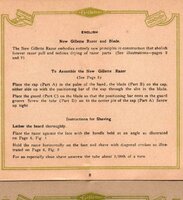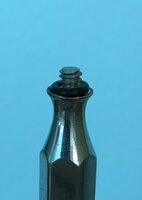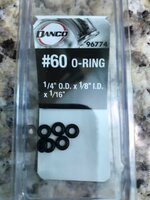Hannah's Dad
I Can See Better Than Bigfoot.
Me — many times.Who ever cut himself changing blades in a 3-piece razor?
Me — many times.Who ever cut himself changing blades in a 3-piece razor?
All the plusses and minuses for each have been covered pretty much so it comes down to preference. I can appreciate both: from a design perspective, 2 & 3 piece razors are simplicity and form-fit-function at its most basic level, nothing wasted, but from a mechanical perspective, TTOs (and especially adjustables) are just plain cool (as long as kept in good working order). I'll reach for either on any given occasion, but 2/3 piece open combs are great for mowing down longer growth without clogging, and TTOs are great for everyday comfort when growth is less.I got the King Gillette razor for Xmas. I tighten it until it gets resistance and then just a bit more.
I'm wondering what the advantages of a 2- or 3-piece razor over the TTO razors are.
I got the King Gillette razor for Xmas. I tighten it until it gets resistance and then just a bit more.
I'm wondering what the advantages of a 2- or 3-piece razor over the TTO razors are.
All the plusses and minuses for each have been covered pretty much so it comes down to preference. I can appreciate both: from a design perspective, 2 & 3 piece razors are simplicity and form-fit-function at its most basic level, nothing wasted, but from a mechanical perspective, TTOs (and especially adjustables) are just plain cool (as long as kept in good working order). I'll reach for either on any given occasion, but 2/3 piece open combs are great for mowing down longer growth without clogging, and TTOs are great for everyday comfort when growth is less.
As for the King Gillette: I've only seen pictures of them--but 2 or 3 local Walgreen stores have had the empty boxes on the shelf (including last night); making it "the most stolen DE Razor" in my area. I grabbed the last 10 pack of King Gillette Razor Blades on the shelf (discontinued/discounted to $2.00). I handed the empty razor box (with blades in it) to the cashier, noting that the blades were still there. I hoped she might throw the blades in for free/discount, considering I was buying the other blades, but no dice. At .20 cents a blade, I figured why not, but does anyone have an impression on if the King Gillette blades are any good?
I have a nylon washer in there as well to help with preserving the plating and helping the setting stick. This idea was first put out by Gillette (minus the washer) in the advertisements so this is how the razor was intended to be used.
I think the washer is simply to preserve plating but almost any three piece can be made more aggressive by loosening the cap slightly and in early Gillette instructions this advice can be seen, here is an example, note the final sentence:I've never encountered this concept before but I'm intrigued. Having trouble visualizing it though. Do you have any pics/diagrams to help illustrate this by chance?

I've never encountered this concept before but I'm intrigued. Having trouble visualizing it though. Do you have any pics/diagrams to help illustrate this by chance?


I share similarly unpleasant memories of Gillette TTOs in that era.Thanks for the info. I'm not sure I got the right size O-ring, but the selection here was limited.
A concern is that the O-ring might put stress on the zamak if tightened too much. On the other hand, an O-ring might provide some cushion against shock, if dropped. Thoughts? I still suggest storing the razor with the handle loosened.
As to the Gillette instructions on loosening the handle etc, if this was for the original, I presume it was a double ring, essentially the same as the later single ring, with the two-part handle, rather than the later Old Type.
You can loosen the handle on the single ring without fear of it coming off, and it seems to stay at the setting fairly well. When you are holding the handle, it is not affecting the turn of the handle on the post, like the regular Old Type, because it is tightened only by the rings at the bottom end of the handle.
Doing this with an open comb is a different concept from a closed comb, which has a gap. There is virtually no gap on the open comb Old Type. It is aggressive enough with the blade exposure and contact. I'm not interested in making it even more aggressive by opening the handle, thank you very much.
The vintage blades I have received with my eBay conquests seem quite stiff compared to modern blades. I think even blades in the 60s and 70s were stiffer.
That said, when I use the Old Type and the New Type, my mind turns to the question of whether users were trying to milk the blades as long as possible for financial reasons, as alluded to by Lefonque's comment.
The New Type long comb was designed before the Great Depression hit. But it seems its aggressiveness would help you to get more out of your blades, a concern in the Thirties. But I haven't used one long enough to know. The New Type do work extraordinarily well with my Sharp Swiss Titanium blades, so it might be quite awhile before I have to change one.
After the OC Old and New Types, closed comb razors seem boring, now.
- A side note likely to PO a lot of users here: I used a Gillette butterfly adjustable razor in the 60s when I was a kid, and hated it -- absolutely despised it. Some mornings my shower looked like a scene from Psycho. I asked my father how to use it, and he said to figure it out yourself. I still don't see any point to adjustable razors. The simple three-piece razor I had before that worked much better. Why do you need to adjust a razor? Just buy a razor with the level you want.
Now with a three-piece razor I clean and dry it after each use, and leave it ready for the next day's shave.
With a TTO, drying it on the spot is impossible. If it is warm and humid, you risk it harboring a staph infection. I don't think they are sanitary. But I'm prejudiced.
Who ever cut himself changing blades in a 3-piece razor?
Why do you need to adjust a razor? Just buy a razor with the level you want.